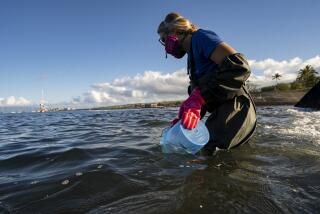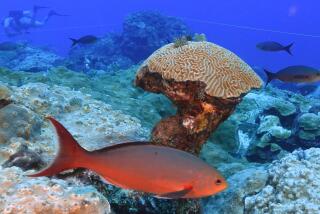A Few Great Dives : Below the waves, an archipelago of nether worlds
- Share via
HONOLULU, Hawaii — Just off Oahu’s windward coast stands a barren island with sheer 225-foot cliffs known to local fishermen as Moku Manu.
Only 15 minutes by small craft from Kailua Beach, this desert island that dots the Mokapu Peninsula is a world removed from civilization.
Until a Hawaiian fisherman took me there on his sampan I had no idea that such raw, wonderful wilderness was so close at hand.
A rookery for frigate birds and boobies, this island has a yawning cave on its sea side and its own coral reef full of bright tropical fish on the lee. Nearby, a U.S. Navy amphibious plane has remained untouched in its watery grave since Dec. 7, 1941, the day the Japanese raided Pearl Harbor.
You won’t find Moku Manu in any Hawaii guidebook even though it offers experienced divers an extraordinary adventure. But you can go there on your own by renting a boat. And that’s my point: almost anywhere you can get in the water in Hawaii is a great place to dive.
You can soar over coral reefs full of bright fish including the humuhumunukunukuapua’a, Hawaii’s official state fish; or swim with endangered green sea turtles and spinner dolphins; and every winter encounter Pacific humpback whales on their annual Alaska migration.
While beginners tiptoe into Hanauma Bay with snorkel and mask, experienced divers probe Hawaii’s reefs, canyons, caves and pinnacles or dive on sunken ships and downed aircraft.
Professional divers are helping the Smithsonian Institution recover relics from King Kamehameha II’s royal yacht, which sank in Hanalei Bay in 1824. Deep water divers in submarines probe Loihi, the new volcano bubbling up off the south coast of the Big Island of Hawaii.
And here’s one for the record books: aquanaut Sylvia Earle planted an American flag on the sea floor off Oahu’s Makapu’u Point in 1979, on the deepest untethered dive in history--1,250 feet.
Every day in the islands, someone is disappearing below the surface of the deep blue tropical Pacific to explore the natural wonders of Hawaii’s underwater world.
Here are 10 other great summer dives on six islands, including one near the privately owned and nearly inaccessible island of Niihau.
Oahu
1) Diving Mahi
In the islands, mahi may be a popular food fish but it’s also a sunken ship off Oahu’s rugged Waianae coast.
This little explored natural side of Oahu, far from Waikiki, offers a great underwater adventure.
In 90 feet of water about a mile off the coast, eels peer from the wreck of the Mahi, a 185-foot minesweeper that lies on its keel. Schools of yellow butterfly fish pose for photos while endangered green sea turtles glide by. Now and then a reef shark shows its pearly whites.
I have a California pal who likes to hide 50-cent pieces in secret places underwater for his friends to discover. He’s hidden half a buck on the Mahi that nobody’s found yet.
Aaron’s Dive Shops; telephone (808) 262-2333.
Maui
2) La Perouse Pinnacle
In 1786, French explorer Jean-Francois de Galaup de la Perouse set foot near Makena Beach, but the first European to visit Maui sailed on, never to be seen again.
His stopover is memorialized by a three-foot stone cairn with a brass plaque on La Perouse Bay, just south of Makena, but another, natural monument lies hidden underwater, unseen by all except snorkelers and divers.
La Perouse Pinnacle rises 60 feet above the sea floor to about 10 feet below the surface of the azure water.
It’s just off the south coast of Maui in the middle of La Perouse Bay, a scenically endowed place where black fingers of lava run to turquoise tide pools.
The submarine landmark attracts schools of damselfish, triggerfish and even the timid bird wrasse. Here, amid coral forests, the deadly fugu puffs up its porcupine quills while goatfish graze daylong in this real fantasy land.
Ed Robinson’s Diving Adventures; tel. (808) 879-3584.
3) Molokini Crater
If you go to Maui and don’t dive Molokini, you’ve missed one of Hawaii’s top dive spots. The sunken 156-foot crater off Maui’s south coast is famous for calm, clear, protected water, abundant marine life--and crowds.
Snorkelers splash around inside the crater basin in 35 feet of water. Scuba divers scale the sloping 70-foot ledge or explore the 350-foot vertical wall on the convex side where manta rays skim black coral trees.
This underwater park is daily visited by a flotilla of dive boats bearing neophytes. Go early, stay late or dive deep to avoid the mob.
Maui Dive Shop; tel. (808) 879-3388.
Big Island
4) Hapuna Beach
I am soaring over scores of blackfish with blue-to-purple polka dots that sparkle like neon in sun rays against a black lava point that is studded with red, blue and yellow coral heads. It’s a rare, wonderful sight.
I discovered this cove on the north end of Hapuna Beach, where black lava pokes boldly into the blue water.
The cove is at the foot of the Hapuna Beach Prince Hotel’s $5,000-a-night bungalow, so you may have to share the water with schools of yellow tangs, needlefish, green sea turtles and possibly even somebody rich and famous.
Some of the world’s best diving is off the Big Island’s leeward coast. Deep water is shielded by Mauna Kea and Mauna Loa, two nearly 14,000-foot high volcanoes; seas are generally calm, water temperature is 75 to 80 degrees with clear water to 100 feet. Of course, there’s no lack of sea creatures.
This excursion is self-guided.
5) Kealakekua Bay
Loaded with sea life, mile-wide Kealakekua Bay daily attracts big barge-like dive boats that disgorge schools of black-finned, pale-faced bipeds who flail about like lost frogs. But so far, fish still outnumber people.
Coral heads, lava tubes, underwater caves all provide excellent underwater habitat for Hawaii’s array of tropical fish. Without looking very hard I always see octopus, free-swimming Moray eels, parrotfish and goatfish, plus clouds of bright yellow butterfly fish, spangles of surgeonfish and ubiquitous wrasses. Once in a while a pod of spinner dolphins streaks across the bay like tossed sequins. You can snorkel, scuba or SNUBA (a tankless dive with a regulator linked by a hose to surface air).
Fair Wind Snorkel & Dive Adventures; tel. (808) 322-2788.
6) Manta Ray Village
How about an underwater encounter with large, feeding mantas? At night? Not for everyone, this thrill dive at Manta Ray Village, outside Keauhou Bay on the Kona Coast, is unforgettable. Great creatures glide on their wing-like pectoral fins into the ray of searchlights as you hover, breathless, in awe.
Kona Coast Divers; tel. (808) 329-8802.
Kauai
7) Caverns
You can play in the waves, snorkel the shallows or dive at Caverns. At Poipu, there are three ways to get wet:
Endless in their attraction, the waves are green-blue and lurid, curling and totally tubular, big enough to hang 10, yet small enough for Gidgets.
Face down, floating like a leaf on a pond, inhaling through a J-tube, I watch little yellow butterfly fish dart here and there in water clear as day.
Way down there, scuba divers probe Caverns. That’s the name for the hot dive spot off Poipu. It’s a submarine complex of arches and lava tubes that attract parades of tropical fish, Hawaiian lobsters and turtles.
Fathom Five Adventures; tel. (808) 742-6991.
8) Tunnels
Honolulu Aquarium is safe, but this will give you an adrenaline rush. On Kauai’s North Shore there’s a great snorkeling beach called Tunnels. The ‘60s puke shell craze began here, and you may still find a few, but Tunnels also is the best place to see Hawaii’s white-tipped sharks in their natural habitat.
An underwater photographer took me there years ago. On the edge of the reef, you dive down about 10 or 15 feet to lava tubes, tunnels created eons ago by molten lava in its rush to the sea.
The tunnels are the lair of mighty, well-fed, 15-foot sleeping sharks. I took a peek and quietly surfaced, heart pounding.
Self-guided.
Niihau
9) Lehua Crater
Mantas and Hawaiian tuna loom about Lehua, the tiny crescent island off Niihau, a privately owned island that is off limits to unauthorized visitors.
It’s 90 minutes by boat from Kauai to Lehua, and it’s the hot new dive spot in Hawaii.
You can dive there now with Bubbles Below, a dive charter out of Kikiaola Harbor run by boat captains Ken and Linda Bail. They scoot across the often choppy channel to Lehua in a 36-foot motorboat on a three-tank trip for experienced divers only.
“It’s good for big stuff,” Ken says. “We usually raise sharks and rays and tuna and almost always see Hawaiian monk seals.”
Divers, he warns, should be comfortable on vertical drop-offs, in huge underwater caverns, in choppy surface conditions and significant currents, as well as sharing space with resident tiger sharks.
Bubbles Below Divers; tel. (808) 822-3483 (summertime only).
Lanai
10) Five Needles
Take a slow boat across Maui’s Auau Channel to dive at Five Needles, a marine landmark on Lanai’s west coast.
One spiky pinnacle stands 110 feet high in the air in constant exclamation. A ragged mass of rocks, called needles, juts skyward to provide a sketchy cove along the vertical cliffs of the Gibraltar-like coast. The boat leaves from Maui’s Maalaea Harbor at 8:45 a.m.
You step aboard the 83-foot SWATH ship just in time for Belgian waffles and strawberries and then set out across the nine-mile channel for Lanai. I’d planned to snorkel until I heard about SNUBA.
A dozen of us leaped into the water like ducklings and began breathing through a regulator attached to a 20-foot hose linked to a floating oxygen tank.
Down and down I go, dangling like a lure, hoping not to attract anything larger than myself, sucking aid at the end of my geographic leash.
Navatek II; tel. (808) 661-8787.
More to Read
Sign up for The Wild
We’ll help you find the best places to hike, bike and run, as well as the perfect silent spots for meditation and yoga.
You may occasionally receive promotional content from the Los Angeles Times.






